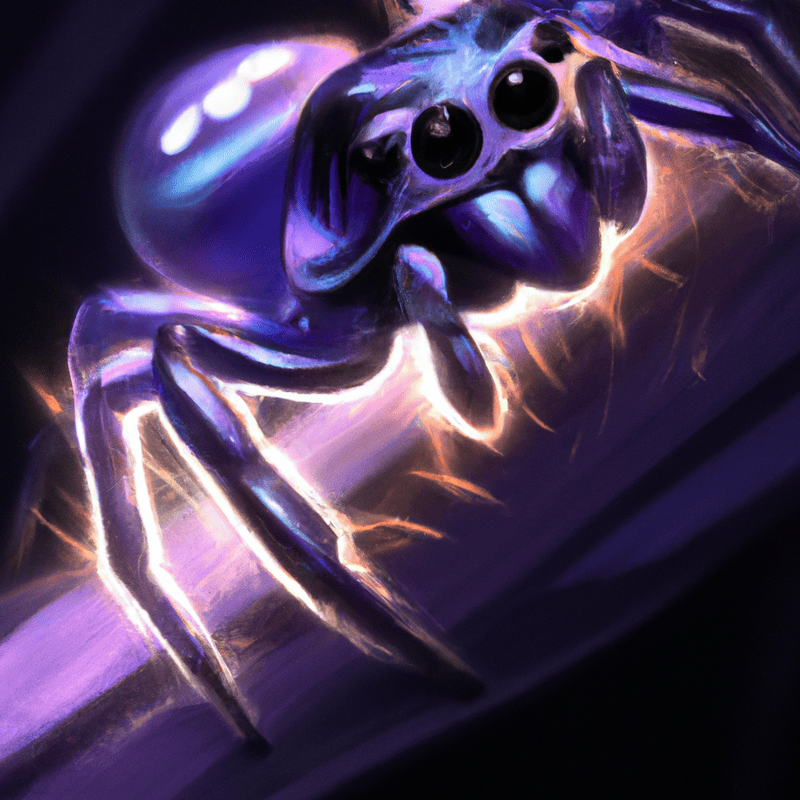Overview of the Regal Jumping Spider
The Regal Jumping Spider is special. It stands out with its metallic green and blue hues and an iridescent sheen. It’s small in size, yet active! Plus, it’s found all over the world.
It’s an excellent hunter. No web-building here – just using silk to make a shelter. And with its forward-facing eyes, it can judge distances when jumping to catch prey or avoid danger.
Males even do courtship rituals before mating, like complex dances and displays of their colorful markings. If you want to observe them up close, keep your distance – it’s better for them. You can also put shelter, like leaves or rocks, in your garden.
Regal Jumping Spiders – the perfect choice if you’re looking for something special!
Physical Characteristics of the Regal Jumping Spider
To understand the unique physical features of the Regal Jumping Spider, you need to explore its body structure, coloration, and size. These sub-sections will help you fully appreciate the intricate characteristics of this species.
Body Structure
Jumping spiders stand out for their special body structure. It helps them jump fast and precisely to catch prey and escape predators. They have two main body parts: the cephalothorax and abdomen. The cephalothorax has eyes, mouthparts, and four pairs of legs. The abdomen houses their reproductive organs.
Their large front eyes are key for hunting and courtship. They can detect movement up to 30 centimeters away and have clear vision. Some species have iridescent scales for visual communication.
The shape and features of jumping spiders let them move quickly and communicate well. To learn more about them, observe them in their natural habitats or in a lab. Take care not to harm them while observing or experimenting. Plus, the Regal Jumping Spider dazzles with its vibrant colors!
Coloration
The Regal Jumping Spider: A Chromatic Marvel!
This tiny creature is known for its chromatic appearance – a stunning mix of purples, blues, greens and reds! Its coloration is not only attractive, but also essential for hunting and mating.
It varies by sex and age. Females tend to be larger, with darker hues, while the young spiders are lighter in color. Male spiders have iridescent scales on their chelicerae, which glow under UV light.
Apart from providing visual appeal, the regal jumping spider’s chromatic display serves as camouflage. This helps them blend in with their environment when hunting prey or escaping predators.
Tip: When observing the regal jumping spider, pay attention to its coloration. It’s quite remarkable to witness its ability to blend in!
Size
Let’s start with the physical characteristics of the Regal Jumping Spider. It is relatively small in size. Here are some details:
- Body length – 1 cm
- Leg span – up to 2.5 cm
- Weight – less than 1 gram
What makes the Regal Jumping Spider special? It has an iridescent colour and can jump six times its body length… without a web!
An interesting fact: male Regal Jumping Spiders perform courtship dances to attract a female. Who needs to travel far and wide when you can find this spider in your own home? If you’re lucky enough.
Habitat and Distribution of Regal Jumping Spider
To learn about the natural habitat and distribution of Regal Jumping Spiders, check out this section. Discover where these spiders reside and their geographic range. We will explore two sub-sections: Natural Habitat and Distribution.
Natural Habitat
Regal Jumping Spiders inhabit various locales around the globe. They dwell in grasslands, forests, deserts, and even urban areas. The US, Europe, Australia, and Asia are some regions where they’ve been spotted. In the US, they are most common in mild-winter regions like Texas and Arizona. Europe has them in countries such as Italy and Spain. Southeast Asia hosts them in its dense rainforests.
These spiders stand out from other species due to their special characteristics. Some have enlarged front legs, while others have bright markings. Furthermore, instead of using webs, they actively hunt for their prey.
Remember: Regal Jumping Spiders are harmless and help to control insect populations. So, if you’re not too ‘jumping mad’ about spiders, these guys can be beneficial to have in your yard or garden.
Distribution
The Regal Jumping Spider is found in many regions around the world. In North America, they inhabit forests, grasslands and deserts. In South America, they live in tropical forests and grasslands. European populations are seen in open fields and meadows, and African specimens are found in scrubland and savannas. Asia is home to mountainous regions and forests inhabited by the Regal Jumping Spider, and Australia is a shrubland hotspot.
These spiders are active during the day and can be seen hunting for prey on green plants and flowers. Researchers at Lund University in Sweden even found that they can spot objects from as far away as 20 centimeters.
Experience a lifetime of adventure with the Regal Jumping Spider!
Reproduction of Regal Jumping Spider
To learn more about how regal jumping spiders reproduce, turn your attention to their mating behavior, egg-laying habits, and how spiderlings grow. Each of these sub-sections will provide key insights into the fascinating reproductive process of these unique spiders.
Mating Behavior
Jumping spiders have impressive courtship behavior during mating. They use visual and acoustic signals to talk. The male spider dances by lifting, waving and flashing his colorful abdomen. The female’s response is important – if she’s interested, she’ll respond.
For copulation, the male uses modified pedipalps on his face to align his genitalia with her reproductive organs. After sperm transfer, he quickly moves away to avoid being eaten.
Some males imitate female behavior by vibrating abdominal hairs to fool males. Then they prey on them before mating with females.
Scientists and researchers have studied jumping spider courtship for centuries. Elias Magnus Fries observed it over 200 years ago. We know a lot about this amazing part of spider reproduction.
The female regal jumping spider can lay up to 50 eggs per clutch. This arachnid knows how to make lots of babies!
Egg-laying
The female Regal Jumping Spider mates and then deposits her eggs in an individual, organized pattern in a silk egg sac. It’s tucked away in a hidden spot, to shield from predators and the environment. Inside the cocoon, the spiderlings develop slowly, with nutrients from their mother’s unfertilized eggs. They moult multiple times until they are mature enough to burst out!
Surprisingly, Regal Jumping Spiders can reproduce multiple times in one year. It depends on food, weather, and genetics. A study at Macquarie University confirms this. So, watch out! These spiderlings will make your house seem even smaller.
How Spiderlings Grow
Spiderling Development and Growth – Awe-Inspiring Process!
Spiderlings start by hatching from eggs and progress through several molts. During molting, they shed their exoskeleton and grow a new one. As they develop, they change their eating habits to meet their growing needs.
| Stage | Description |
|---|---|
| Egg | (0-7 days) Eggs are laid by female spiders |
| First Instar | (1-5 days) Very small and fragile. Relies on yolk sacks for nourishment |
| Second Instar | (5-10 days) Gets larger. Begins to hunt for food |
| Third Instar | (10-14 days) Develops hunting skills |
| Fourth Instar | (14-19 days) Grows more complex features |
| Fifth Instar | (19-24 days) Fully grown and ready to leave its mother |
Temperature, humidity, and food access all affect spiderling development. It’s an intricate process needing the perfect balance of conditions.
Don’t Miss Out!
Witness the fascinating spiderling growth process up close! The Regal Jumping Spider is particularly picky, only eating the best flies and gourmet insects.
Diet of Regal Jumping Spider
To learn about the diet of regal jumping spider, this section titled “Diet of Regal Jumping Spider” with sub-sections “What the Spider Eats” and “Hunting Behavior” will be your ultimate guide. Discover the variety of prey that these spiders feed on and their unique hunting behaviors to catch their food in the wild.
What the Spider Eats
The Regal Jumping Spider is a carnivore with a menu that includes flies, ants, and moths. It’s been witnessed preying on smaller spiders of its own species! Studies show that juvenile spiders have a broader diet than adult spiders.
It’s fascinating to watch these acrobatic creatures in action as they use their visually acute eyesight to accurately gauge prey movements and pounce with precision.
The future holds incredible discoveries about the Regal Jumping Spider’s diet and how it affects their development and behavior. Don’t miss out!
Hunting Behavior
The Regal Jumping Spider is an incredibly agile hunter. Its hunting technique is all about perfect timing, precise movements, and smooth actions. It uses its sharp vision, touch, and air vibrations to track down even the hardest to find prey.
The spider hides in camouflage and waits for the perfect moment to jump out and grab its prey. It’s unpredictability makes it even more successful.
These regal spiders even have a taste for other spiders, such as small jumping spiders which they can eat whole.
Research by the Australian Museum reveals that while they are not venomous, they can bite if provoked or threatened.
Despite their regal title, these jumping spiders would rather chow down on flies than attend a royal feast.
Behavior and Lifestyle of Regal Jumping Spider
To understand the behavior and lifestyle of Regal Jumping Spiders in depth with respect to Social Behavior, Communication, and Night vs Daytime Activities, this section provides valuable insights. Each sub-section sheds light on a different aspect of their life, which will help you appreciate the unique nature of these tiny, yet fascinating creatures.
Social Behavior
These fascinating creatures, known as Jumping Spiders, display unique social behavior. Complex courtship rituals and a communal lifestyle have been observed. They communicate through visual signals such as body posture and vibrational signaling. They form temporary communities during mating season and share food!
In addition, these spiders show impressive hunting skills. They use cunning tactics to locate prey. They stalk insects and other arthropods with stealthy movements and ambush techniques. Their vision and hearing amplify their agility in the wild.
Did you know? Scientists have found that Jumping Spiders can recognize faces! A study conducted by University of California scientists found that these spiders have a specialized area in their brain for facial recognition. This groundbreaking study was published in Nature in 2015.
The Regal Jumping Spider understands that sometimes, actions speak louder than words!
Communication
Jumping spiders communicate using visual cues like body posture and color. They also use vibrations and chemicals to find mates and stake out territory. This ability to adapt has been seen in many species of regal jumping spiders. A cool fact is that males tap their pedipalps (near the mouth) on surfaces to make drumming sounds during courtship!
To understand communication amongst regal jumping spiders, watch them carefully and analyze their behavior. Especially when they’re mating! It’s key to know how they communicate, as it can help us understand social roles, mate selection, habitat choice and survival strategies.
Pro Tip: Look out for environmental factors that may affect communication, such as lighting or other disturbances. Why not skip the nightlife and witness a regal jumping spider’s daytime parkour instead?
Night vs Daytime Activities
Regal Jumping Spiders have unique characteristics throughout the day. Here’s an overview of their behaviors and actions:
- During the day, they are more active and look for prey. They jump from leaf to leaf.
- In the afternoon, they build nests with silk for the night.
- At night, they are less active and rest in their silk nests.
- With their excellent eyesight, they spot movement at night and hunt for prey in the dark.
- These spiders can also change their activities easily based on their environment.
Plus, they have an amazing talent – they can jump up to 50 times their body length using their legs’ hydraulic power! Not only are Regal Jumping Spiders cute, but they also help to keep your home insect-free – what a great deal!
Importance and Benefits of Regal Jumping Spider
To understand the importance and benefits of regal jumping spiders in their ecosystem, dive into the ecological role they play. In addition to that, discover the potential medicinal uses of these tiny yet mighty creatures.
Ecological Role
Regal Jumping Spiders are vital for maintaining ecological balance. They hunt pesky insects and arthropods that harm plants or crops. Plus, they help with pollination and seed dispersal.
These spiders have great eyesight which helps them take down prey bigger than themselves. They are also skilled architects who build webs with care.
Unlike other spiders, Regal Jumping Spiders are very active. They jump around searching for food or mates, dispersing pollen and seeds in the process.
In India’s ancient Sanskrit language, these tiny, brave creatures were called ‘Danaeru‘. Their intelligence and hunting abilities have been admired for centuries, making them important to various cultures.
So, one can say Regal Jumping Spiders are more than just ecological heroes.
Medicinal Uses
The regal jumping spider has more than just its looks! It has medicinal uses – its venom is filled with bioactive compounds, like antioxidants, antimicrobials and anti-cancer properties.
Its venom could be used to treat chronic pain and cardiovascular disorders. And perhaps even Alzheimer’s. Its unique venom compounds could lead to new drugs with fewer side effects and better results.
What an opportunity! We must explore this amazing creature and its potential contribution to humankind. It may be small, but don’t be fooled – there’s a reason it’s called ‘regal’. The revolutionary advancements it could bring us are too great to ignore.
Threats and Conservation of Regal Jumping Spider
To understand how to protect the regal jumping spider, you must be aware of certain threats to the species and conservation efforts. In order to achieve this, we will explore the two sub-sections – threats to the species and conservation efforts.
Threats to the Species
The regal jumping spider is facing multiple challenges that threaten its existence. Human interference, like deforestation and urbanisation, have caused displacement of the spider from its habitat, leading to population reduction. Pesticides used in farming are also toxic – they can cause malformations or death, and collectors for specimen trade add even more pressure.
Various NGOs are working on conservation efforts, such as teaching local communities the value of the spider and the risks of biodiversity loss due to extinction. Intensive research is also being done into beneficial management practices of agricultural lands within the Regal jumping spider’s range.
In Thailand, a woman has been breeding these spiders for years. She takes care of them and harvests crops without using pesticides. Her business exporting spider eggs helps her sustain a livelihood whilst conserving local biodiversity.
Saving the regal jumping spider may seem like a small victory, but every little superhero counts in the fight against biodiversity loss.
Conservation Efforts
The regal jumping spider is a crucial part of nature’s biodiversity, but it is under threat from human activities. To save it, we must be diligent!
Raising awareness about the spider’s importance is key. Habitat conservation and restoration will help provide a safe environment for them. Researching the spider’s behavior and biology is essential, too. Doing this will make a big difference for conservation.
We must also implement strict policies to stop illegal wildlife trafficking and capture. Everyone should be involved in this journey to preserve natural heritage.
We must act now to protect the regal jumping spider. They keep pest populations in check, which benefits crops, gardens, forests, and other ecosystems. Let’s not fear them – with conservation efforts, we can make sure that they stay kings of their habitat.
Conclusion and Summary of the Regal Jumping Spider.
The Regal Jumping Spider – a remarkable arachnid – deserves some spotlight! This guide has provided lots of info about their characteristics, habitat, behavior and reproduction.
Their hunting prowess, awesome jumping skills and unique eye structure attract people worldwide. Plus, they show social behavior – they’re fun to watch!
Discover more about their complex communication style – body language and dance moves – as well as their potential benefits for controlling insect populations.
As a suggestion, observe them in their natural habitats without disturbing them. Furthermore, planting native vegetation in gardens can help create an ecosystem that welcomes these exquisite creatures.
Frequently Asked Questions
1. What is a regal jumping spider?
A regal jumping spider is a type of spider known for its striking coloration and unique behavior. These spiders are small, agile hunters that use their jumping ability to catch prey.
2. Where can I find regal jumping spiders?
Regal jumping spiders can be found in many parts of the world, including North and South America, Europe, and Asia. They are often found in grassy areas, forests, and gardens.
3. What do regal jumping spiders eat?
Regal jumping spiders are carnivorous and feed on insects such as flies, moths, and other spiders.
4. Are regal jumping spiders dangerous?
No, regal jumping spiders are not dangerous to humans. They are not venomous and are generally docile creatures.
5. How can I identify a regal jumping spider?
Regal jumping spiders are known for their bright coloration, which can include shades of green, blue, and red. They also have large eyes and a compact, muscular body.
6. What is the lifespan of a regal jumping spider?
The lifespan of a regal jumping spider varies depending on the species, but most live for about one year.

Alex Hartford, the founder of Reptile Truths is dedicated to uncovering the fascinating truths about reptiles, promoting their conservation, and sharing his knowledge with others.

